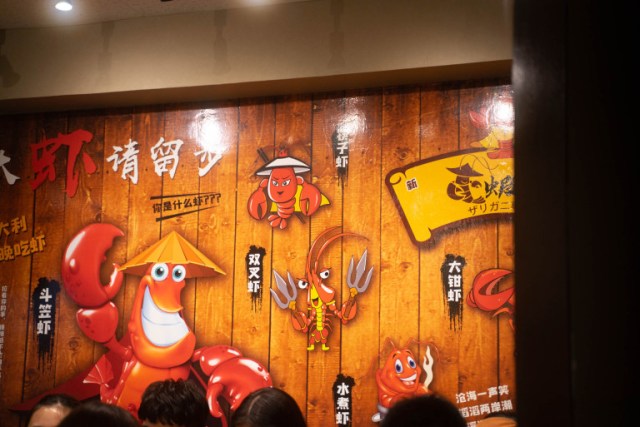
This Takadanobaba restaurant blew us away with its delicious Chinese-inspired dishes!
Crayfish aren’t really popular to eat in Japan, despite being native to the country. Still, that doesn’t mean you can’t find a good place to eat them. In fact, there is a restaurant in Tokyo exclusively dedicated serving crayfish…and since it was the best dang crawdads we’ve eaten this side of the Pacific Ocean, you better believe we’ll be back!
The restaurant is known as Ebido, and is located in the university neighborhood of Takadanobaba in Tokyo. It’s just 10 minutes straight down the road from Takadanobaba Station on the JR Yamanote line, and has a sign outside that says, “zarigani senmonten” (ザリガニ専門店), meaning “restaurant specializing in crayfish.”
We were surprised to see that many people were stopping outside to take a look at the menu. Whether that was because it’s quite a rare cuisine to specialize in, or because the pictures of the crayfish rice bowl looked delicious, we couldn’t say. A peek inside the restaurant revealed more pictures of curious crayfish dishes, like “Mala Crayfish”, “Garlic-flavored Crayfish”, and “Chinese Food Therapy Crayfish”, so we could not wait to try it.
We had booked a reservation for 5p.m., just after the restaurant opened. We arrived on time and were immediately glad that we had a reservation because the place was already packed just minutes after opening.
A waitress greeted us at the door in Chinese, then responded in perfect Japanese when we told her we had a reservation. She led us to our table in the bustling dining room, where nearly everyone else was speaking Chinese. Thankfully, the menu was also written in Japanese and all the staff could speak Japanese, so we didn’t have any trouble making our orders.
Though the menu has some items that don’t use crayfish, most of the dishes do. We decided to start with the “zarigani-don”, the crayfish rice bowl we’d seen on the sign outside, for 1,280 yen (US$12.17), but we wanted to order something else, too…for the sake of journalism, of course.
We were eyeing one of the three specialty-looking dishes, the “Mala Crayfish”, the “Garlic-flavored Crayfish”, or the ‘Five-spice Crayfish”, because, as it turns out, you can order these dishes with crayfish with their heads on. We were super excited because that’s a rare treat, but then the serving staff told us that you can only get the heads if you order it ahead of time. Bummer! We ended up ordering the “Five-spice Crayfish” anyway, because it was the one that was the most mysterious-looking to us.
By the way, the restaurant also sells a good selection of your standard izakaya drinks, like highballs and Asahi Super Dry beer, as well as soft drinks like oolong tea and green tea, so there is plenty to both eat and drink at this little seafood bar.
In addition to the full house, there was a continuous stream of take-out customers who appeared to have ordered ahead of time. The amount of crayfish dishes that were bussed out of the kitchen was astounding, and from what we could see, it looked like there were only a few people working in the kitchen!
Consequently that meant we had to wait a fair bit before we received our food, but we didn’t mind. We suspected that this restaurant was responsible for a major portion of the demand for crayfish in Tokyo, so of course we would have to wait. But if you plan to eat here, we recommend giving yourself about two hours to get in, get your food, and eat, and that’s with a reservation. Otherwise it might be better to call ahead and set a time to take out your meal.
We waited about thirty minutes for our first dish, the zarigani-don. At first glance, it looked a bit like “ankake shrimp”, which is a popular Chinese dish, though at a closer look the little crustaceans were definitely crayfish.
They actually tasted like shrimp, too, but when we took time to carefully savor the flavor, we noticed it did have a faint hint of fresh water. Plus, the texture was much firmer than shrimp and gave us the impression of an animal with a leaner body.
The sheer volume of crayfish was astounding! They probably made up about 80 percent of the dish. We didn’t count exactly, but we estimated that there were about 25 on our plate. There was so much of it that we began to regret ordering a second dish…but it was so good we ate it all up!
Then, after another thirty minutes, our five-spice crayfish arrived. It was beautifully presented, and with its complex mixture of spices, it looked and smelled delicious.
This dish came with crayfish that still had their shells on. Unlike shrimp shells, which are somewhat soft and can be eaten, the crayfish shells are way harder, so you can’t get away with forgetting to peel one.
Curled up, the crayfish looked like some kind of mysterious fruit, or a new variety of nut, but when we impaled it on a chopstick, we saw its true shape. They were definitely crayfish, no doubt about it!
On the underside we could see its little skinny legs sticking up. It made us understand why some people won’t eat shrimp and other shellfish “because they look like bugs”.
To eat this dish, we had to don a pair of disposable plastic gloves that came with with it and peel off the shells. Even though it was a little extra work, we could not get enough of the flavors of the “five-spice crayfish“. It was like eating barbecued shrimp, but Chinese style. With the unique flavor of the five-spice seasoning, the firmness of the crayfish meat, and the slightly briny aroma of the dish as a whole, we were pretty enthralled. The crayfish rice bowl was delicious, but this was even better.
Though the menu prices are a little high, we can vouch for the quality of the food at Ebido, and if you won’t take our word for it, consider the fact that the restaurant was full within minutes of opening, and that there was a continuous stream of takeout orders throughout our dine-in experience. When we left the restaurant, there was a line out the door, even though it was raining outside.
Since we hadn’t heard much about this restaurant from our Japanese friends, it might be mostly popular among the Chinese-speaking residents and frequenters of Takadanobaba. Though it’s known mostly as a top neighborhood for ramen, Takadanobaba is home to several Japanese language academies as well as the elite Waseda University, so there are sure to be many international students who frequent the restaurant. Why not check it out next time you’re in the area?
Restaurant Information
Ebido / 蝦道
Tokyo-to Shinjuku-ku Nishi-Waseda 3-21-2 basement level 1
東京都新宿区西早稲田3-21-2 B1F
Open 5 p.m.-11 p.m.
Photos © SoraNews24
● Want to hear about SoraNews24’s latest articles as soon as they’re published? Follow us on Facebook and Twitter!
[ Read in Japanese ]

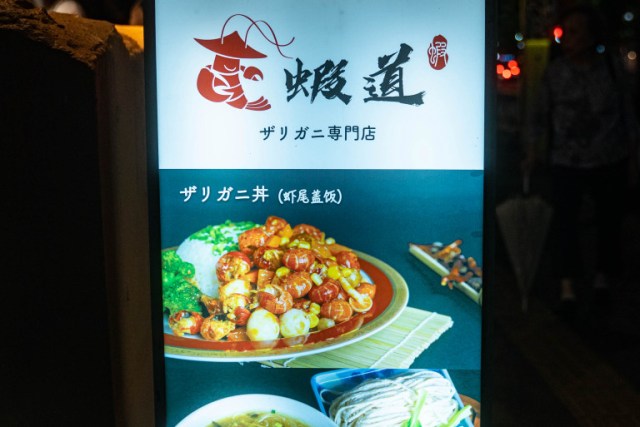
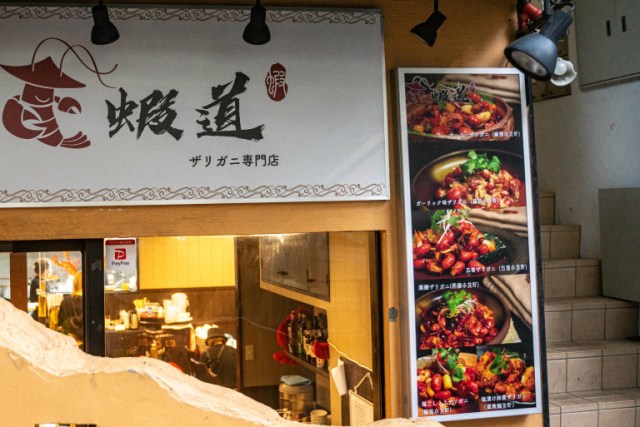
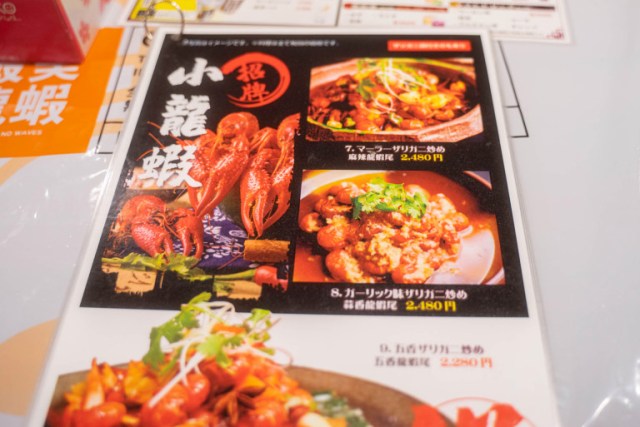
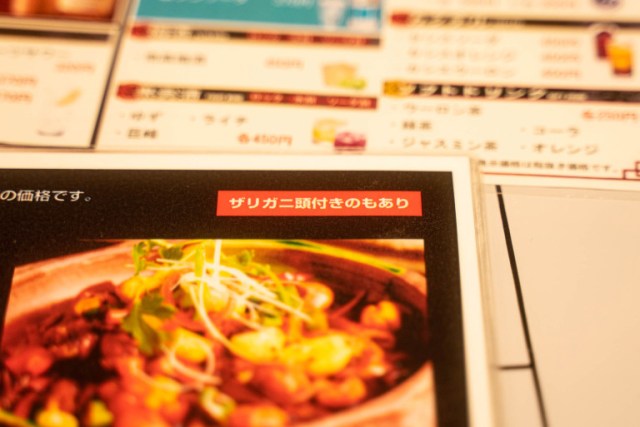
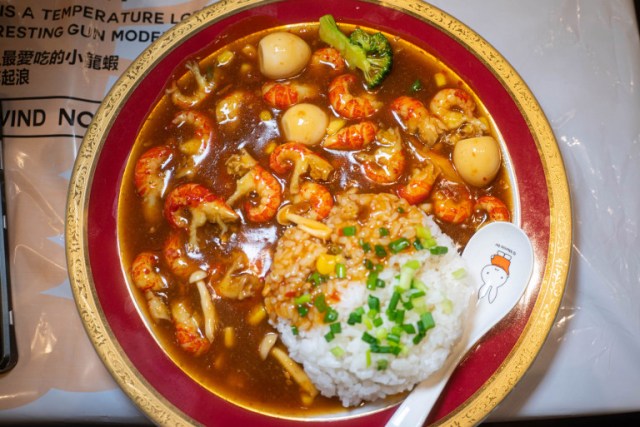
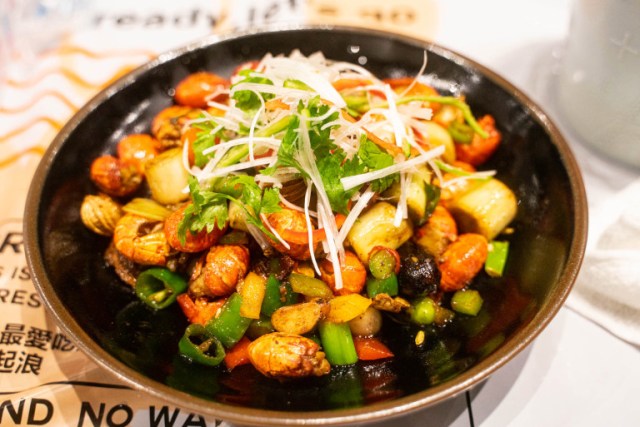
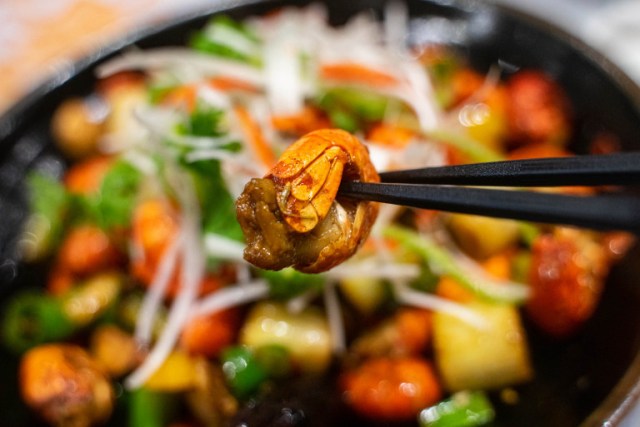
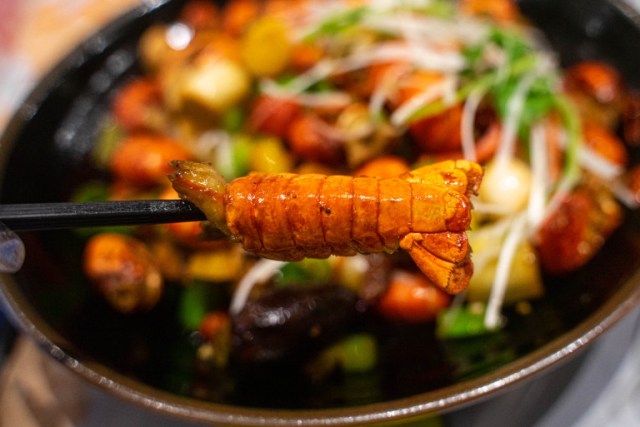
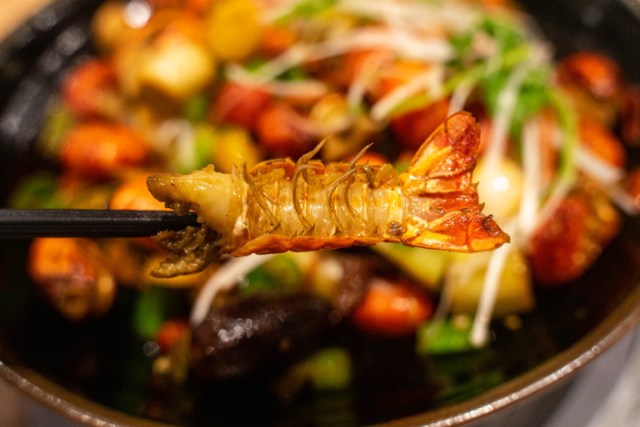
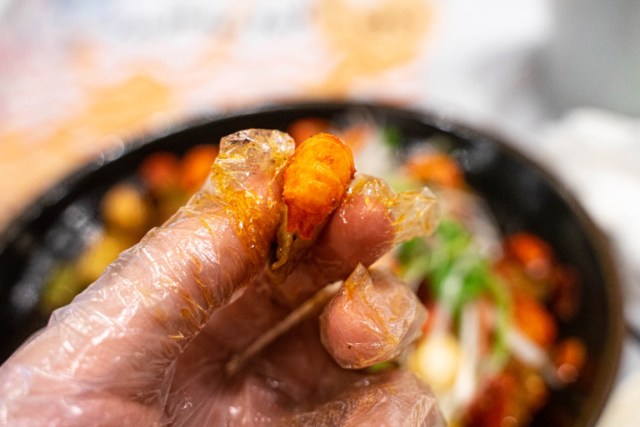
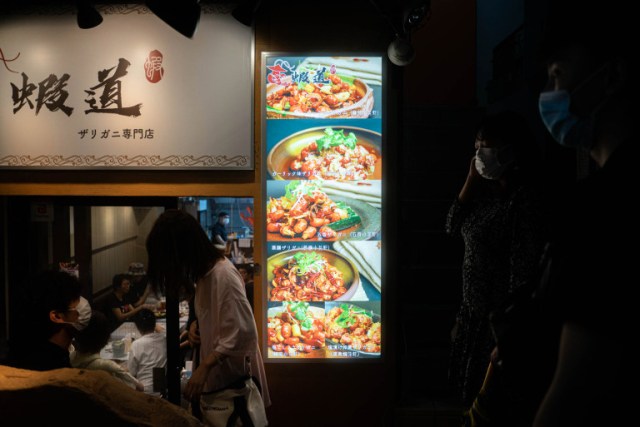
 Fishin’ for crawdads in Tokyo: A tale of friendship
Fishin’ for crawdads in Tokyo: A tale of friendship Gyoza ramen! Two of Japan’s best comfort foods in one bowl at innovative restaurant【Taste test】
Gyoza ramen! Two of Japan’s best comfort foods in one bowl at innovative restaurant【Taste test】 Crayfish claw mistakenly eaten whole becomes huge pain in the ass
Crayfish claw mistakenly eaten whole becomes huge pain in the ass This is the one and only kakuni pork bowl restaurant in Tokyo, and it’s amazing
This is the one and only kakuni pork bowl restaurant in Tokyo, and it’s amazing Tonkotsu ramen rice bowl blows our minds, makes us appreciate noodles in a new light
Tonkotsu ramen rice bowl blows our minds, makes us appreciate noodles in a new light Red light district sushi restaurant in Tokyo shows us just how wrong we were about it
Red light district sushi restaurant in Tokyo shows us just how wrong we were about it Pokémon Sleep camping suite and guestrooms coming to Tokyo Hyatt along with giant Snorlax burgers
Pokémon Sleep camping suite and guestrooms coming to Tokyo Hyatt along with giant Snorlax burgers Sandwiches fit for a sumo served up in Osaka【Taste Test】
Sandwiches fit for a sumo served up in Osaka【Taste Test】 Akihabara pop-up shop sells goods made by Japanese prison inmates
Akihabara pop-up shop sells goods made by Japanese prison inmates McDonald’s new Happy Meals offer up cute and practical Sanrio lifestyle goods
McDonald’s new Happy Meals offer up cute and practical Sanrio lifestyle goods Japan’s massive matcha parfait weighs 6 kilos, contains hidden surprises for anyone who eats it
Japan’s massive matcha parfait weighs 6 kilos, contains hidden surprises for anyone who eats it Starbucks Japan adds a Motto Frappuccino to the menu for a limited time
Starbucks Japan adds a Motto Frappuccino to the menu for a limited time Haku is…Chihiro’s dead brother? Studio Ghibli fans blown away by Spirited Away theory
Haku is…Chihiro’s dead brother? Studio Ghibli fans blown away by Spirited Away theory Studio Ghibli releases new action figures featuring Nausicaä of the Valley of the Wind characters
Studio Ghibli releases new action figures featuring Nausicaä of the Valley of the Wind characters Are you a sloucher? Get a cute, furry little friend to help correct your posture at your desk
Are you a sloucher? Get a cute, furry little friend to help correct your posture at your desk All-you-can-drink Starbucks and amazing views part of Tokyo’s new 170 meter-high sky lounge
All-you-can-drink Starbucks and amazing views part of Tokyo’s new 170 meter-high sky lounge More foreign tourists than ever before in history visited Japan last month
More foreign tourists than ever before in history visited Japan last month Japanese ramen restaurants under pressure from new yen banknotes
Japanese ramen restaurants under pressure from new yen banknotes French Fries Bread in Tokyo’s Shibuya becomes a hit on social media
French Fries Bread in Tokyo’s Shibuya becomes a hit on social media New private rooms on Tokaido Shinkansen change the way we travel from Tokyo to Kyoto
New private rooms on Tokaido Shinkansen change the way we travel from Tokyo to Kyoto Starbucks reopens at Shibuya Scramble Crossing with new look and design concept
Starbucks reopens at Shibuya Scramble Crossing with new look and design concept Studio Ghibli glasses cases let anime characters keep an eye on your spectacles
Studio Ghibli glasses cases let anime characters keep an eye on your spectacles Beautiful Ghibli sealing wax kits let you create accessories and elegant letter decorations【Pics】
Beautiful Ghibli sealing wax kits let you create accessories and elegant letter decorations【Pics】 Studio Ghibli releases Kiki’s Delivery Service chocolate cake pouches in Japan
Studio Ghibli releases Kiki’s Delivery Service chocolate cake pouches in Japan New definition of “Japanese whiskey” goes into effect to prevent fakes from fooling overseas buyers
New definition of “Japanese whiskey” goes into effect to prevent fakes from fooling overseas buyers Our Japanese reporter visits Costco in the U.S., finds super American and very Japanese things
Our Japanese reporter visits Costco in the U.S., finds super American and very Japanese things Studio Ghibli unveils Mother’s Day gift set that captures the love in My Neighbour Totoro
Studio Ghibli unveils Mother’s Day gift set that captures the love in My Neighbour Totoro New Japanese KitKat flavour stars Sanrio characters, including Hello Kitty
New Japanese KitKat flavour stars Sanrio characters, including Hello Kitty New Pokémon cakes let you eat your way through Pikachu and all the Eevee evolutions
New Pokémon cakes let you eat your way through Pikachu and all the Eevee evolutions Disney princesses get official manga makeovers for Manga Princess Cafe opening in Tokyo
Disney princesses get official manga makeovers for Manga Princess Cafe opening in Tokyo Sales of Japan’s most convenient train ticket/shopping payment cards suspended indefinitely
Sales of Japan’s most convenient train ticket/shopping payment cards suspended indefinitely Sold-out Studio Ghibli desktop humidifiers are back so Totoro can help you through the dry season
Sold-out Studio Ghibli desktop humidifiers are back so Totoro can help you through the dry season Japanese government to make first change to romanization spelling rules since the 1950s
Japanese government to make first change to romanization spelling rules since the 1950s Ghibli founders Toshio Suzuki and Hayao Miyazaki contribute to Japanese whisky Totoro label design
Ghibli founders Toshio Suzuki and Hayao Miyazaki contribute to Japanese whisky Totoro label design Doraemon found buried at sea as scene from 1993 anime becomes real life【Photos】
Doraemon found buried at sea as scene from 1993 anime becomes real life【Photos】 Tokyo’s most famous Starbucks is closed
Tokyo’s most famous Starbucks is closed One Piece characters’ nationalities revealed, but fans have mixed opinions
One Piece characters’ nationalities revealed, but fans have mixed opinions We asked a Uniqlo employee what four things we should buy and their suggestions didn’t disappoint
We asked a Uniqlo employee what four things we should buy and their suggestions didn’t disappoint Princesses, fruits, and blacksmiths: Study reveals the 30 most unusual family names in Japan
Princesses, fruits, and blacksmiths: Study reveals the 30 most unusual family names in Japan 6 things you should try at Sushiro right now, according to staff who work there
6 things you should try at Sushiro right now, according to staff who work there Super Budget Dining in Japan – What’s the best way to spend 1,000 yen (US$6.70) at Saizeriya?
Super Budget Dining in Japan – What’s the best way to spend 1,000 yen (US$6.70) at Saizeriya? Mr. Sato attacks a massive castle of seafood at a new restaurant in Tokyo Skytree’s Solamachi
Mr. Sato attacks a massive castle of seafood at a new restaurant in Tokyo Skytree’s Solamachi Asakusa luxury – the best matsutake soba we’ve ever had at a price that can’t be beat
Asakusa luxury – the best matsutake soba we’ve ever had at a price that can’t be beat This triple jumbo shrimp rice bowl hides a shrimpressive surprise
This triple jumbo shrimp rice bowl hides a shrimpressive surprise Tokyo’s new frozen ramen vending machines are brain-breakingly amazing【Taste test】
Tokyo’s new frozen ramen vending machines are brain-breakingly amazing【Taste test】 We made three kinds of hassle-free dashi soup stock using the handily microwavable Dashi Pot
We made three kinds of hassle-free dashi soup stock using the handily microwavable Dashi Pot Hello Kitty dim sum restaurant serving up dishes of cuteness in Hong Kong
Hello Kitty dim sum restaurant serving up dishes of cuteness in Hong Kong We try to eat almost 9 pounds of food at a Nagoya spaghetti shop, succumb to the power of carbs
We try to eat almost 9 pounds of food at a Nagoya spaghetti shop, succumb to the power of carbs “Hey Singaporean taxi driver! Take us to the best restaurant in Singapore!”
“Hey Singaporean taxi driver! Take us to the best restaurant in Singapore!” We visit super popular tuna specialty joint Izakaya Hitoshi on Okinawa’s Ishigaki Island
We visit super popular tuna specialty joint Izakaya Hitoshi on Okinawa’s Ishigaki Island Mermaids and Fried Wikipedia: the art of translating menu items into English
Mermaids and Fried Wikipedia: the art of translating menu items into English Eat like a big kid at this Kyoto cafe with their “Kids’ Special” just for grownups!
Eat like a big kid at this Kyoto cafe with their “Kids’ Special” just for grownups! Which conveyor belt sushi place’s chawanmushi egg custard is the best? We investigate【Taste Test】
Which conveyor belt sushi place’s chawanmushi egg custard is the best? We investigate【Taste Test】 We found the prettiest TKG ever at a restaurant specializing in raw eggs on rice in Tokyo
We found the prettiest TKG ever at a restaurant specializing in raw eggs on rice in Tokyo
Leave a Reply